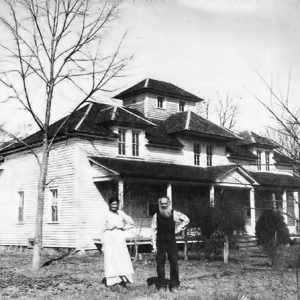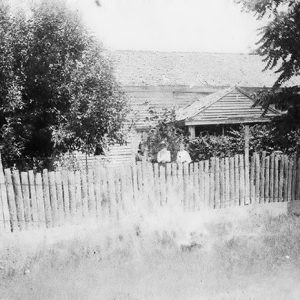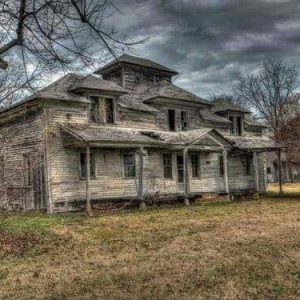calsfoundation@cals.org
Rowland-Lenz House
The Rowland-Lenz House, located northeast of Benton (Saline County) on Highway 5, was listed on the National Register of Historic Properties on February 11, 2004. Originally built as a two-story dog-trot log house, its late nineteenth-century modifications make it an interesting example of Swiss/German-influenced construction applied over an existing log home.
The house, built in 1838 by Thomas Rowland with slave labor, was occupied by the Rowland family until 1848. At that time, the house was rented by John Nelson and purchased by him in 1850. The Nelson family occupied the home from 1848 to 1873, when it was purchased by former Confederate colonel and circuit judge Jabez M. Smith upon Nelson’s death. Smith rented the home to his brother, David Smith, and family.
After the death of Jabez Smith in 1891, Swiss immigrants Joseph and Salome Lenggenhager purchased the home and remodeled the main portion to its present structure. In 1922, their daughter Alwina Lenggenhager Lenz and husband Wilhelm inherited the home. After Alwina Lenz died, her son Oscar Lenz took ownership of the house, where he remained until his death in 1992. An associated barn, most likely built by Joseph Lenggenhager in the late nineteenth century, is a good example of the kind of barn found across Arkansas farmsteads but with a slight European flair in construction.
The Rowland-Lenz House is the oldest standing structure in Saline County. Located on the Southwest Trail, or Military Road, it witnessed the growth of Arkansas from just after statehood to the current growth of Saline County in the twenty-first century. The home was visited during the Civil War by Union and Confederate soldiers but remained undisturbed by both. An associated cemetery nearby contains numerous descendants of the Nelson family, while Rowland slaves are believed to be buried nearby.
Architecturally, the original logs of virgin timber were notched in a manner allowing them to interlock without protruding past the ends of adjacent logs. This allowed the siding to be applied soon after construction. After purchasing the home, Lenggenhager added a bedroom on the north side of the west pen. Later, the Lenz family added a two-story addition on the north side of the east pen. This accommodated the kitchen downstairs and a bedroom upstairs. A root cellar for food storage was dug underneath the home at some point.
While the original structure is still relatively solid, the new additions by Lenz have fallen in or deteriorated badly. An effort began to deed the house and associated barn to Saline County Preservation, Inc., a nonprofit organization dedicated to preserving Saline County structures and historic sites. The preservationists stated that their goal was to restore the home to its 1890s appearance as a historic home of Saline County, detailing its antebellum history, as well as the history of late nineteenth-century Swiss/German immigration to Saline County.
For additional information:
“Hester-Lenz House.” National Register of Historic Properties nomination form. On file at Arkansas Historic Preservation Program, Little Rock, Arkansas. Online at http://www.arkansaspreservation.com/National-Register-Listings/PDF/SA0046.nr.pdf (accessed September 3, 2020).
Anthony Rushing
Benton, Arkansas
 Arkansas Historic Preservation Program
Arkansas Historic Preservation Program Historic Preservation
Historic Preservation Louisiana Purchase through Early Statehood, 1803 through 1860
Louisiana Purchase through Early Statehood, 1803 through 1860 Lenggenhagers
Lenggenhagers  Rowland-Lenz House
Rowland-Lenz House  Rowland-Lenz House
Rowland-Lenz House 




Comments
No comments on this entry yet.